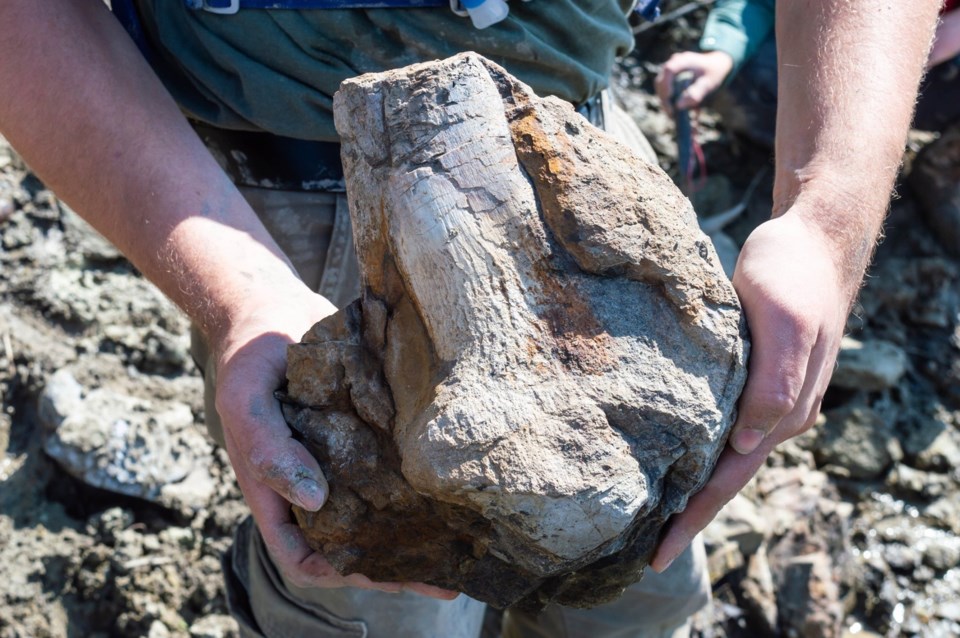In northwest Alberta, far from the badlands and traditional ‘dinosaur country’, an international team of paleontologists has been hard at work searching for fossils in the Peace region. The Boreal Alberta Dinosaur Project (BADP) is dedicated to learning more about this relatively new frontier of paleontology in Alberta.
Much of the digging for fossils happens near Grande Prairie. Rivers like the Wapiti and Redwillow flow through deep valleys that cut through the surrounding forests and farmlands, and in these valleys, rocks from the late Cretaceous period can be searched for fossils. Due to the rugged terrain and remote nature of the region, the fossil record of the area wasn’t studied much until the discovery of a massive horned dinosaur bone bed near the town of Wembley in the early 70’s.
The fossil deposits around Grande Prairie are important for other reasons. In the late Cretaceous period, the Western Interior Seaway divided North America in half, with its western shore running the north-south length of central Alberta. Most of our best-known fossil sites come from what was once the flat, swampy lowlands near the shore of this ancient sea. The region now explored by the BADP team, however, was both further north and inland.
“We're pushing the known fossil record of Cretaceous vertebrates in Alberta into an area where we might expect to see a higher-latitude fauna with some unusual features - species that don't occur further south, for example,” said University of Alberta paleontologist Dr. Corwin Sullivan, who is also the curator of the Philip J. Currie Dinosaur Museum near Grande Prairie. “What we have in northwestern Alberta is an unbroken terrestrial record spanning the last 13 million years or so of the Cretaceous. Parts of that record are richer than others, but it's all there.”
Many of northwestern Alberta’s more productive fossil sites, found in a layer of rock called the Wapiti Formation, date back to a 1.5-million-year time when sea levels were extra high, flooding most of southeastern Alberta and leaving a gap in the land animal fossil record from that slice of time. Sullivan noted, “The southern Alberta record can't tell us what was going on with dinosaurs and other terrestrial vertebrates during that particular interval, but northwestern Alberta has the potential to fill the gap.”
Each summer, the BADP team finds more important specimens, and this year was no different. “This seemed to be the year of dinosaur skin, or more specifically hadrosaurid skin,” said Sullivan about the abundance of duck-billed dinosaur skin impressions found by the team. Fossils formed when the scaly hides of dinosaurs left impressions in soft mud which then filled with minerals and hardened into rock over millions of years. Skin impressions tell paleontologists a lot about what dinosaurs looked like when they were alive. “Skin deep doesn't have to mean superficial," Sullivan said.
Despite the important discoveries made the BADP team, northern Alberta paleontology is just ramping up. There’s plenty more questions to ask and bones to find.
“The overarching mystery is how the dinosaurs and other vertebrates of the Wapiti Formation compare to those from places like Dinosaur Provincial Park,” noted Sullivan. “Are we sampling a distinct northern fauna, or was the same assemblage of species present more or less throughout Alberta during the Late Cretaceous?”
Dr. Sullivan has no shortage of prehistoric mysteries to tackle, and is optimistic about the future of research in northern Alberta. In addition to finding new fossil sites of different ages, the team is also still learning about well-established bone beds.
“We have an intriguing partial horned dinosaur skull from a site on the Redwillow River that we call the Hotte Spot, and a couple of really nice hadrosaurid skulls that have yet to be described," he said. "And all that skin! There's so much - but I suspect that the most significant finds still lie ahead, and will turn up where they're least expected.”
Nick Carter is a writer, photographer and naturalist from Edmonton. See more at naturenickphotography.com



